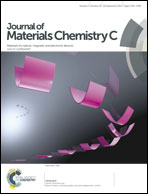Synthesis of nitrogen-doped graphene by chemical vapour deposition using melamine as the sole solid source of carbon and nitrogen
Abstract
Nitrogen doping is a promising method to modulate the electrical properties of graphene. However, the reported nitrogen-doped graphene (NG) films usually show low electron concentration and low carrier mobility. In this study, we have demonstrated the chemical vapour deposition of NG films, where melamine was used as the sole source of both carbon and nitrogen. The studies show that the nitrogen content and configurations are strongly dependent on the growth temperature. At a growth temperature of 990 °C, the total N content and graphitic-N/total N simultaneously reached the maximum values of ∼5.6 at% and ∼40%, respectively. Further, the electrical studies reveal that the NG film displays typical n-type behaviour in air. The Dirac point and mobility were determined to be ∼−25 V and ∼74 cm2 V−1 s−1, respectively, which indicate that the as-synthesized NG film has high electron concentration and high carrier mobility. This can be attributed to the significant increase in the ratio of graphitic-N to total N, because graphitic-N has a higher electron donor ability and shows lower carrier scattering than do pyridinic-N and pyrrolic-N. This study is beneficial for not only the carrier transport mechanism, but also potential applications of NG film.


 Please wait while we load your content...
Please wait while we load your content...